official aid
Aid for rural development
Rural Development
1. Overview
KOICA endeavors to assist in the rural development sectors in developing countries by utilizing Korea’s past experience in increasing agricultural output and improving rural living standards. More specifically, KOICA chose three major goals for developing countries including increasing agricultural output, improving access to agricultural and fishery markets and heightening rural living standards. Since KOICA’s foundation, the amount of aid to the rural development sector has steadily increased. When KOICA was first established in 1991, aid to the rural development sector amounted to USD 1.37 million. This amount drastically increased to USD 47.3 million in 2010. The share of rural development aid which accounted for 6% of KOICA’s total aid budget in 1991 increased to 11% in 2010.
2. Performance
Since the establishment of KOICA, the nations it has cooperated with have mainly been in the Asia region where it has participated in giving rural development sector support. However, since 2007 aid toward the least developed countries became a stronger requirement for the achievement of MDGs and the importance of aid toward Africa increased. This resulted in dramatic expansion of cooperative projects in Africa. Rural development sector ODAs in Africa which accounted for less than 5% of projects at KOICA’s inception, now account for approximately 40%.
3. Strategy and Institutional Improvement
KOICA initiated rural development projects to achieve MDGs by relieving food shortages and alleviating poverty in developing countries. To further these goals, KOICA has executed its projects by focusing on technical support to strengthen human resource capacity. KOICA distributes support according to regional and national natural environments and income levels. KOICA intends to take full advantage of Korea’s experience in rural development to create specialized systems that help alleviate rural poverty and food shortages in developing countries. To reach this goal, KOICA will utilize its original rural development programs that conform to the support systems of countries. It will also work to strengthen its human resource networks.
In addition to development projects that aim to increase agricultural production through infrastructure construction, KOICA also seeks to cultivate comprehensive methods of aid. Expanding opportunities for education and improving the level of health and welfare conditions can increase the overall quality of rural life. KOICA is gradually expanding its field of activities to carry out these goals. The methods of aid and the expansion of its range are essential business requirements to effectively meet the diverse development demands of rural regions. Through change and innovation, KOICA’s future rural development projects can become a leader in ODA business.
Therefore, in the lowest income countries, KOICA projects will emphasize the establishment of basic living conditions. In the low and middle income countries with the highest income levels, agricultural production and aid towards the processing and logistics of agricultural products will be the focus. KOICA also pursues differentiated strategies with respect to the region. In Asia for instance, KOICA supports the construction of basic agricultural facilities. In Africa, KOICA focuses on transferring production technologies and cultivating basic agriculture to address food shortage problems. Rural development sector aid is driven by 8 specific goals, of which the 3 main goals include: ① Increasing agricultural productivity; ② Expanding access to agricultural markets; ③ Improving rural living environments and increasing incomes.
To reach these goals, KOICA comprehensively considers the specific needs of each country and utilizes Korea’s past experiences in increasing agricultural production and rural environment improvement.
[Figure 3-1] The Rural Development Sector Strategy
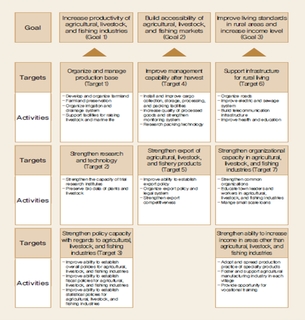
Aid for the rural development sector aims to confront issues concerning the growth of developing countries, poverty eradication and climate change. To effectively confront these problems while considering the appropriateness of aid, KOICA selects development experiences to transfer to developing countries. It also systematizes aid programs. To strengthen ODA specialization, KOICA works to expand its specialized human resources and strengthen its partnerships with specialized institutions.
Rural development sector projects reflect the relevance of the field. Interest in the field has increased domestically and internationally, especially within the past five years. Furthermore, rural areas in developing countries show varying conditions in aspects such as population size, location and culture. As a result, it is essential to acquire partnerships that strengthen specialization and contribute to the effectiveness and efficiency of projects. KOICA constantly improves the institutions that allow it to prepare for these needs.
First, KOICA implements rural development projects by combining diverse methods of aid to increase agricultural production and improve the environment. In 2007, KOICA conducted regional research by utilizing specialized external institutions with the aim of increasing the level of specialization in the initial stages of project planning. Secondly, KOICA gathers comprehensive agriculture related information regarding the countries it cooperates with to ensure execution of its rural development projects is effective and customized. By accurately knowing the status of diverse rural areas in each country, aid strategies and original project plans can be better assessed in terms of their feasibility. While compiling information regarding the status of agricultural and rural development policies, and main agricultural products of countries, KOICA also seeks information on ODA projects of other current donor countries. By comparing the development and main agricultural indices of cooperating countries, the planning and implementation of projects from a complete perspective is possible.
Thirdly, KOICA establishes the pool of specialists in the rural development sector and utilizes this resource in project planning and implementation. Currently, within ten sectors including rural development, agricultural processing and stockbreeding, 240 specialists who are registered in this pool are participating in feasibility studies and project evaluations. In addition to expanding its pool of specialists, KOICA continuously aims to maintain the level of activity of specialists through evaluations.
Lastly, KOICA helped to construct 12 universities and networks related to the rural sector. It also established a program for the formation and administration of a specialized rural development committee, and is currently selecting members for this committee.
Source: Korea International Cooperation Agency. 2011. 20 years of KOICA 1991-2010, Translated by Institute for Development and Human Security, Ewha Womans University. Seoul.
4. Best Practices
A. Cambodia Kampong Cham Province Development Project
This project utilized the experience of Korean rural development as its basis and presented a new model for rural development inside Cambodia, beginning with the goal of growth. The Cambodian villages of Chong, Tabaek and Stung Chhveng were selected as candidates for the commencement of pilot projects. While the projects were implemented, organizations such as the village development committee allowed village residents to participate directly in the planning and establishment of the pilot projects. These included the construction of town halls and repairing of its roads and libraries. By promoting the active participation of village residents while completing the project, KOICA fostered cooperation between the two groups and strengthened the self-reliance of residents. The rural development ministry of Cambodia, through the success of the Korean rural development model, proclaimed the three villages as “Model Villages.”Thereafter, the ministry promoted visiting and observation of the “Model Villages”by people in other regions. The ministry thanked the government of Korea and planned to spread the pilot project across the country.
[Figure 4-1] A small reservoir created as a result of project in Kampong Cham
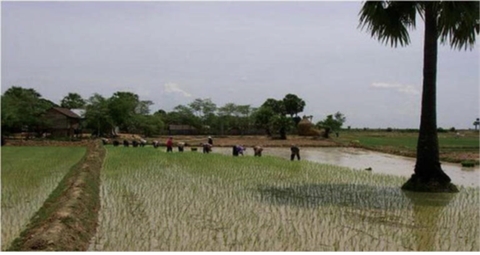
[Figure 4-2] Field research for making project plans
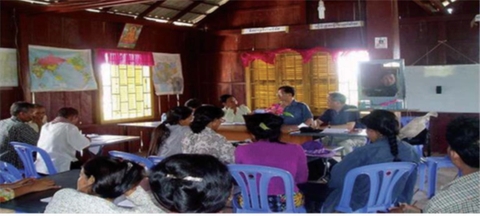
B. El Salvador Vegetable Cultivation Productivity Improvement Project
The El Salvadorian government presented its plans for “value-added production expansion”as the agricultural part of its national development plans “(Pais Seguro).” To increase agricultural sector income, it set improvement of cultivation technologies and exportation of crops as national policies. Despite having the appropriate natural conditions to cultivate vegetables, El Salvador lacked basic agricultural facilities and skills, which hindered their ability to take advantage of their favorable conditions. As a result, the El Salvadorian government requested the commencement of this project. The project focused on the transfer of crop cultivation technologies to increase rural income and help alleviate chronic poverty.
This project included human resource orientated development aid (infrastructure aid). It also dispatched specialists and trainers to complete greenhouse construction and the remodeling of the farming-skills support center. Korea’s advanced technologies provided support to build greenhouses and develop small local greenhouses led by water supply institutions. This cultivated indigenous technologies of the cooperating countries. After the completion of the project, KOICA dispatched crop cultivation specialists to continuously provide crop cultivation and greenhouse maintenance support. In addition, El Salvador publicized the greenhouses at the local and national level, using them as a model example. This contributed to the positive image of Korea in that country. Korean media also publicized the project as a model case through major media outlets, increasing the promotion of KOICA projects and strengthening awareness towards ODA.
[Figure 4-3] Vegetable cultivation in greenhouse
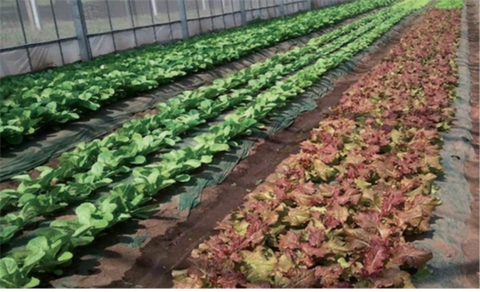
[Figure 4-4] Education and Training
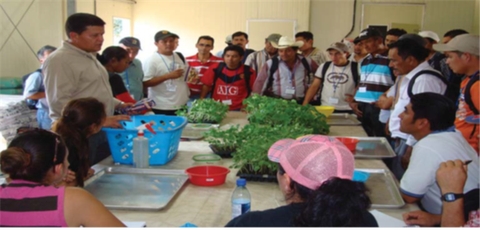
C. Senegal Podor Region Irrigation Development Project
This project was implemented to address Senegal’s most urgent national issue, the improvement of its self-sufficiency in food production. Farming skills were also improved by providing irrigation development farming technologies for the length of the 45km river. A town hall was also constructed with the aim of improving the lifestyle of residents. The Senegalese government developed, cultivated and irrigated farmland in the Delta region thereby expanding the amount of arable land. The government sought to improve agricultural productivity. During the initial planning stages, joint Action Plans established the project, reflecting local requirements. To maximize the reach of the project, infrastructure construction and farming skills support were linked. The consistent rural development policies of the Senegalese government combined with the existing KOICA projects (including the agricultural productivity improvement project in the Dagana region and the irrigation feasibility study and farmland development project in Grande Digue-Tellel) is expected to increase project effectiveness.
[Figure 4-5] Teaching agricultural techniques
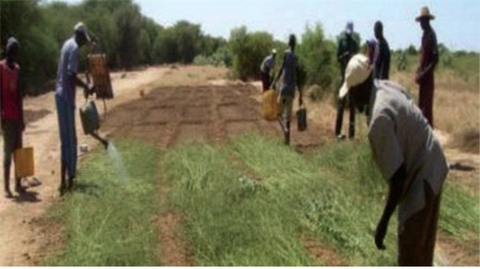
[Figure 4-6] Information on project area
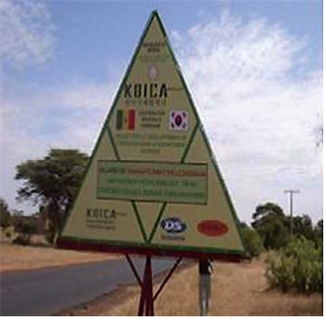
Source: Korea International Cooperation Agency. 2011. 20 years of KOICA 1991-2010, Translated by Institute for Development and Human Security, Ewha Womans University. Seoul.
